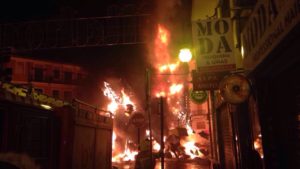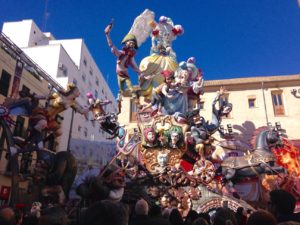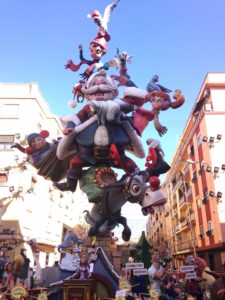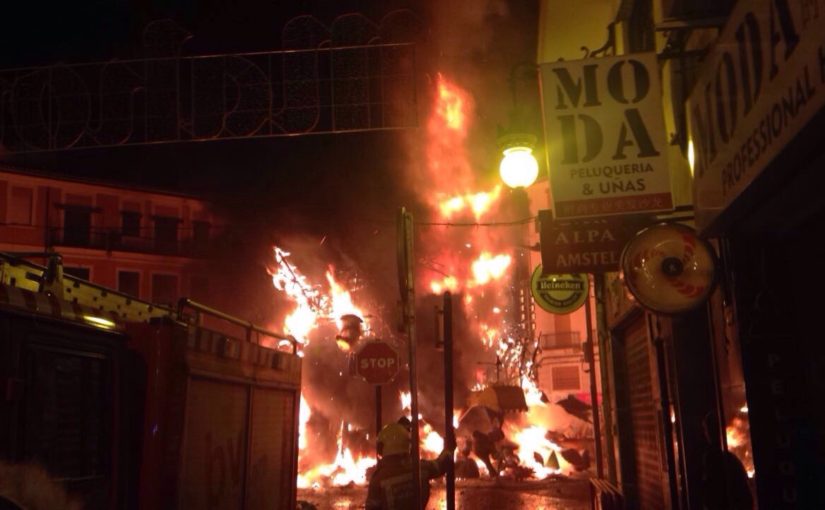If you asked me what Las Fallas was before the festival, I would have given you a vague response about it being some big festival in Valencia.
Las Fallas is one of the craziest festivals in the world. It’s the festival that sets the city on fire … literally.
So what is Las Fallas? Starting on March 1 and running through the 19, with the main events happening from the 15 through the evening of the 19, Las Fallas is the celebration of the end of winter and the start of spring. The origins of the festival come from the celebration of the feast day of St. Joseph, the patron saint of carpenters.

Las Fallas started as a time for carpenters to clear their workshops of the leftover scraps of wood. Using old parrots, or planks of wood used to hang candles, the carpenters would add the scraps of wood and light the pile on fire. Before long, these piles waiting to be burned were created into huge, beautiful monuments, called the “Fallas.”
As the years passed, the celebration of Las Fallas evolved, with the Fallas going up in flames on the last night of festivities.
Throughout the year, each neighborhood association plans, fundraises and builds their Falla. Usually, each association agrees on a theme, sometimes ranging from the political situation at the moment to mythical creatures and stories.
From there, ninots, or the sculptures that make up the entire Falla, are designed and created. Made from papier-mâché, wood and some paint, these works of art are not cheap to make, relying mainly on donations each year. Some can cost upward of $40,000 or more.
Every association is allowed to submit one ninot to the annual exhibition, where the community can come and vote on which one is the best. The ninot that wins is saved from the fires on the last night and has a place waiting in the Fallero Museum with the previous years’ winners.


The Fallas are hard to miss once the installation process has begun on March 17. Simply walk any street in the city and it is guaranteed you will run into a massive Falla in the middle of the intersection.
Every morning, each neighborhood starts its day with La Despertà at 8 a.m. La Despertà, also referred to as the wake-up call, consists of music playing in the streets and firecrackers being thrown.
You will often hear children throwing petardos, or firecrackers, into streets at all hours of the day. Just be careful at night and watch where you walk to ensure that you don’t walk right into one about to explode.
While the main events don’t start until March 15, Mascletà begins on the first and continues on a daily basis. Mascletà is the large display of gunpowder explosions taking place in Plaza del Ayuntamiento. Mascletà isn’t an event about the view; it’s the event about the sound and the vibrations under your feet.
For an average of seven minutes, the ground shakes beneath your feet and your ears ring from the explosions. While being 50 feet away from the explosion site provides the ultimate experience, standing down a side street gives you an equally unique experience, as the sound bounces off the buildings. Each explosion gets louder and stronger, leading up to a huge finale, so loud your eardrums feel like they are going to burst and you are left wondering whether or not you will ever gain your hearing back.
Firework displays begin on the 15, with the largest one, called the Nit del Foc, on the 18. These fireworks are definitely 10 times better than the ones you buy every year for the Fourth of July. Spectators are allowed to stand so close that the debris from the fireworks rain down on you.
Throughout the festival, live music fills the days. Food trucks line the streets. The most notable ones being the chocolate and buñuelo stands. The chocolate in Spain is a rich, creamy and slightly thick version of hot chocolate. Buñuelos are comparable to mini-doughnuts; however, you then proceed to dip them into the cup of chocolate you bought because you can’t have one without the other.
Espectacular de Luces in the Russafa neighborhood is also worth a look. While most neighborhoods are decorated with lights in the street during Las Fallas, none can quite compare to the display Russafa has.
On March 17, La Ofrenda de Flores, or the Offering of Flowers, begins. Each Fallas association dresses in traditional costumes, ornate dresses and clothing and parades through the streets until they reach the Plaza de la Virgen. Each member carries a bouquet of flowers, an offering to Our Lady of the Forsaken, the Patron Saint of Valencia. Each bouquet is placed on a 15-meter tall statue of the Virgen.
March 19, the final day of Las Fallas, begins with a floral offering to St. Joseph followed by a Solemn Mass to honor St. Joseph at the Cathedral. The Procession of Fire begins as dusk approaches. It’s sort of like the parade from hell where people dress in devil-like costumes and sparks fly everywhere from staves and mechanical creatures.
When the clock strikes 10 p.m., the moment everyone has been waiting for arrives: La Cremà, or The Burning.
The first ones to burn are the Infantiles, the smaller Fallas constructed by the children of each association. Each one is lined with fireworks, providing a colorful show as each Falla goes up in flames. At midnight, the rest of the Fallas are set on fire, burning until only ashes remain.
The next morning, the streets are clean and life returns to normal, leaving you slightly tired from the festivities and a few pounds heavier from all the chocolate and buñuelos you consumed during the past 19 days. All that is left is from the Festival of Fire are the memories burned in your mind.
